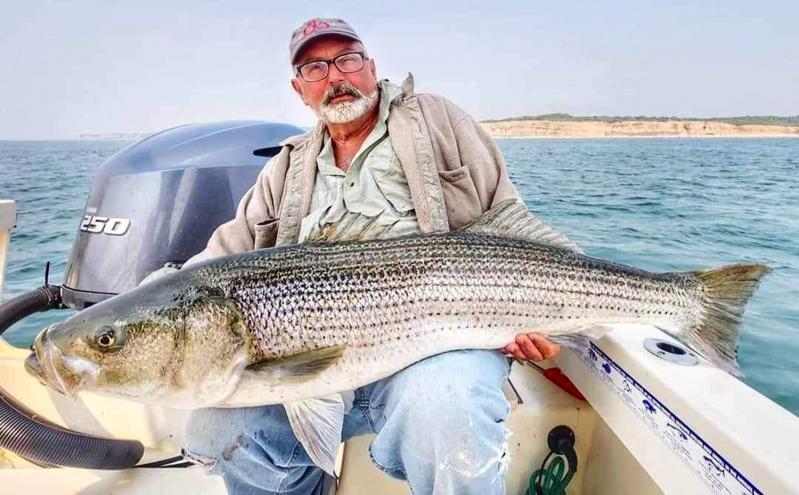Back in October, the Maryland Department of Natural Resources announced the results of its annual juvenile striped bass survey, which tracks the reproductive success of Maryland’s state fish in the Chesapeake Bay. The news was not good.
The 2023 young-of-year index was a paltry 1.0, well below the long-term average of 11.1. It’s the fifth consecutive year of well-below normal results.
While the Hudson River is a well-known spawning ground for the popular game fish, the broad expanse of the Chesapeake Bay is widely considered to be the largest producer of juvenile striped bass on the East Coast. Efforts to rebuild the bass population have been underway for several years and are ongoing.
Low levels of spawning stock in recent years have spurred action by the Atlantic States Marine Fisheries Commission, which manages the overall population of striped bass along the Atlantic Coast, to put forth a comprehensive management plan to rebuild the stocks of striped bass.
In May, the commission’s Atlantic Striped Bass Management Board initiated the development of a draft addendum II to amendment 7 — a 2022 overhaul to the Atlantic striped bass management plan — after revised stock-rebuilding projections showed that the chance of rebuilding the striper stock by 2029 has dropped from 97 percent to 15 percent due to overfishing and increased fishing mortality rates during the 2022 season. The draft addendum additionally proposes options for the board to respond to stock assessment updates more quickly if future projections indicate that the stock is not expected to be rebuilt by 2029.
The commission’s mandate, which New York enacted on June 20, reduced the slot size for bass from 28 to 35 inches to 28 to 31 inches, in a step to better protect large breeding fish. While anglers were still allowed to retain one fish per day, it was a controversial decision that rattled the cages of many constituents who wet a hook and line.
A number of fishermen, especially those running for-hire boats, complained that the reduced slot-size restriction would result in increased mortality of bass being released, as it would take a much longer time to potentially cull out a keeper striper for their fares. Others argued that a full moratorium would be the prudent move, while another group argued that only fish over 36 inches should be kept and retained.
Sometime in January, the commission will vote on additional regulation changes aimed at reducing striped bass mortality caused by coastwide fishing activity, including in the Chesapeake Bay. Many anxiously await the final verdict.
Why the downfall of spawning success in the Chesapeake? Marine scientists have concluded that striped bass spawning activity is water-temperature driven, and historically adult fish migrated to the Chesapeake Bay to spawn in April and May, which aligned with the arrival of plankton that larval striped bass feed upon. However, recent winters have produced lower than average snowfalls in the region, and therefore less snowmelt to cool the rivers and streams where striped bass spawn.
But others opine that the population of striped bass, much like that of other species, including fluke and sea bass, has gradually shifted northward in its migration, feeding, and spawning patterns. As a result, they hypothesize there are now fewer striped bass swimming and spawning in and about the broad Chesapeake Bay region.
“I see more bass now than even five years ago,” remarked Capt. Dan Giunta of the Double D, a Montauk charter boat. “It’s not like where we were at in the mid-late ’90s, but that was an all-time historic high for stripers. They also are so hung up on the young of the year out of the Chesapeake. They don’t breed there as much anymore; the stock has shifted northward.”
Giunta pointed to the Long Island Sound biomass as an example of an area where no assessments are done. “They are breeding in the Connecticut and Housatonic Rivers, but they don’t look at them for stock assessment. They need to move with the fish. Stripers are in Nova Scotia now, yet they still look only at North Carolina, Virginia, and the Chesapeake Bay.”
Public comment on the four proposals, all of which include different slot-size restrictions, ended last week. Guinta supports an option that would provide for a 28-to-33-inch slot for charter and party boats, while private vessel and shore anglers would continue with the current 28-to-31-inch slot limitation.
“This option will increase the slot size by two inches for the for-hire fleet,” explained Giunta. “The increased slot of two inches only changes the harvest reduction percentage from 14.1 percent to 14 percent. This difference is so negligible it should be a no-brainer. It reiterates the tiny slice of the pie that the for-hire fleet represents within the recreational sector. This will decrease catch-and-release mortality by keeping more striped bass in the water.”
The longtime skipper added that “the less time I spend bass fishing will equate to less bass killed. It’s plain and simple.” The Montauk Boatmen and Captains Association, of which Guinta is a member, also supports that option.
Capt. David Blinken, who runs North Flats Guiding, a light-tackle fishing guide service in East Hampton, disagrees with Giunta’s observation that stripers are plentiful, and would even support a full moratorium on the retention of any striped bass.
“I’ve clearly seen a significant decline of striped bass for many years now,” he said. “My log book clearly points out the trend and it’s very alarming. At times this season I had to travel to Fishers Island and Rhode Island to find some bass. More needs to be done to bring back the striped bass population.”

